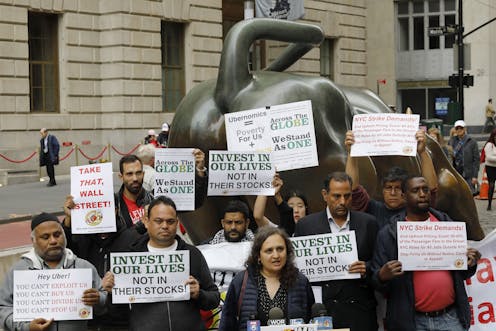Uber drivers strike and the future of labor: 4 essential reads
- Written by Bryan Keogh, Economics + Business Editor

Uber drivers across the globe logged out of their company’s app[1] for several hours on May 8 to protest its compensation policies.
Strikes occurred in at least eight U.S. cities including New York and San Francisco as well as places as far-flung as London and Melbourne. They were timed to coincide with Uber’s initial public offering, which is expected to raise US$90 billion for the ride-hailing app on May 10.
Drivers are demanding better job security and higher wages. Their status as independent contractors often denies them some employee rights. And studies show[2] many drivers earn less than $10 an hour after expenses.
The walkout raises questions about the future of worker mobilization in the age of the gig economy. Here are four stories from The Conversation archive that offer lessons for today’s worker activists.
1. 1919 Seattle strike offers hope
A century ago, 35,000 shipyard workers and 25,000 other union members – roughly a fifth of Seattle’s population – walked off their jobs to demand higher wages.
The Seattle General Strike of 1919 shut down a major U.S. city, inspired a rock opera, provoked fears Russian Bolsheviks were trying to overthrow American capitalism and, ultimately, was an abject failure in achieving its ends, wrote University of Oregon history professor Steven C. Beda. Yet the incident offers “surprisingly hopeful” lessons[3] for today’s striking teachers, Uber drivers and others, he argued.
“It had proven to workers, both in Seattle and elsewhere, that there was power in unity, however fleeting,” Beda recalled. “For five days, workers had shut down the city and then run it themselves.
"For today’s workers tired of decades of wage stagnation and fleeting benefits in the gig economy, the Seattle General Strike offers an important lesson about the power of organized laborers: When united, workers can take on the most powerful foes,” he wrote.
2. Google and the power of customers
Late last year, thousands of Google employees staged a walkout to demand changes to the way their company handles sexual harassment complaints. The company pledged to overhaul its policies.
The grievances that motivated the protest, the first of its kind by well-paid and benefit-rich high-tech workers, were “emblematic of what’s prompting millions of American workers to feel they have lost their voice,” argued Thomas Kochan, a professor of management at MIT.
To find it again, they should look to a similar walkout[4] by employees of Massachusetts-based Market Basket in 2014, which Kochan called the “most successful strike of the 21st century.” The employees won their battle because of strong customer support, a strategy Google workers should follow, he wrote.
“Although labor law won’t protect them, they might be able to use the hundreds of millions of Google’s customers – of its search engine, email program or mobile phone software – to pressure executives to negotiate in good faith,” he wrote. They “could not only end up changing their company’s policy on harassment, but become the vanguard that could help disrupt U.S. labor law in the process.”
3. Teachers fighting for social justice
Teachers in several cities in the U.S., including Oakland, California, also went on strike last year.
While low teacher pay was one of the motivations, they were also protesting[5] the lack of funding for student resources. And in the process, they enlisted the help of student and community groups and focused on racial justice, explained Rebecca Tarlau, an assistant professor of education and of labor and employment relations at Pennsylvania State University.
“All these actions have transformed the Oakland Education Association – and many other teachers’ unions across the country – into leaders of a social movement that has the potential of redefining public education, the labor movement and American politics,” she wrote.
4. Risks of inaction
Despite some success, the power of unions to represent workers has plummeted in recent decades as their ranks have dwindled.
MIT’s Kochan, a frequent contributor to The Conversation on the future of labor, also wrote about three key questions that need to be answered[6] by all American workers, from high-tech Googlers and gig economy drivers and “taskers” to underpaid teachers. But he also warned of risks.
“Unless talk leads to actions to change the course of the economy and labor market, the next generation of workers is destined to experience a lower standard of living than their parents – the opposite of the American Dream,” Kochan argued.
This story is a roundup of articles from The Conversation’s archives.
References
- ^ logged out of their company’s app (www.vox.com)
- ^ studies show (www.ridester.com)
- ^ offers “surprisingly hopeful” lessons (theconversation.com)
- ^ they should look to a similar walkout (theconversation.com)
- ^ they were also protesting (theconversation.com)
- ^ three key questions that need to be answered (theconversation.com)
Authors: Bryan Keogh, Economics + Business Editor
Read more http://theconversation.com/uber-drivers-strike-and-the-future-of-labor-4-essential-reads-116772

